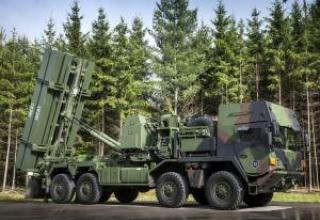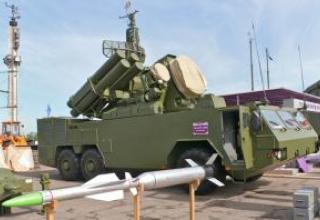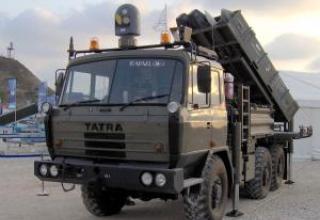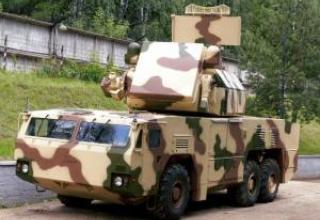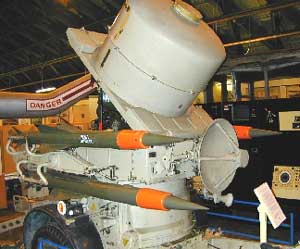
Rapier-Laserfire" SAM system is designed for air defense of objects and fire support of units on the march and provides defeat of helicopters and airplanes at ranges up to 5 km and altitudes up to 3000 m in day and night conditions. The development of laser-guided SAMs has been driven by the increased threat posed by the latest generation attack aircraft and the low effectiveness of lightweight, wearable SAMs in repelling this threat.
Development of "Rapier-Laserfire" complex on the basis of existing "Rapier" SAMs was started by "VAe" company in 1982 as an initiative and was completed one year later than planned (in view of the problems with software development) in 1989. The Rapier-Laserfire development programme amounted to 50 million SFR ($81 million). This complex competes with such short-range SAMs as RBS-70 and ADATS.
Composition:
Rapier-Laserfire" differs from existing samples of SAMs by the presence of a laser device for automatic tracking of targets detected by radar. This station has a narrow directivity diagram and provides precise coordinates to the laser system of target tracking. The station has a high resolution capability. On the control panel of the radar there are screens of two displays; on the left one the air situation is displayed, on the right one the image transmitted by the laser tracking system is reproduced.
When the "Rapier-Laserfire" SAM system is included into the general air defense system, data on the priority action zones against the enemy air targets, i.e. the zones which are protected by this system, are entered into the ASU of the complex. In this case the laser tracking system automatically switches on the first target detected by the radar. The system design allows the operator to interrupt the target acquisition process and manually switch the system to another target. The detection radar has high noise immunity in relation to electronic countermeasures and a high degree of stealth during operation.
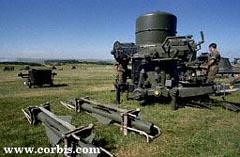
Ferranti's 629 type laser on yttrium-aluminum garnet activated by neodymium (AYG:Nd) is used in the laser target tracking system. The system operates in pulsed mode with high pulse repetition frequency. It contains a quadrant receiver of reflected laser energy and a processor that analyzes signals reflected from the target and provides automatic tracking of the target. The processor is developed by VAe on the basis of Argus M700 design. The laser of the tracking system is used simultaneously to measure the distance to the target. The screen, which displays the air situation, has an alphanumeric indication of data about the target coordinates, range to the target and speed of the target. Special display equipment, such as the Cossor 880, can also be provided in the system structure. The operator can also identify the target on the TV screen. In the metre detection radar area, the operator can manually point a laser tracking system at the target.
All component parts of the complex, including the calculation cabin, are placed on a swivel standard platform, which can be installed on any military vehicle with a payload of 3-4 tons, including: on the chassis of the truck "AWD" (4x4 wheel formula) with a payload of 4 tons, tracked APC M548, Stormer and Warrior, Bedfort's "MIR1". The regular system "Rapier-Laserfire" has no independent power unit and is driven by the carrier engine. There is a shelf variant of the SAM system which is equipped by the built in power block. SAMs of "Rapier-Laserfire" on a rotary platform have overall dimensions: length 3300, width 2400, height 1900 mm. The weight of the complex is 2000 kg. To protect stationary objects, the platform can be installed on the ground.
The complex is air transportable. Two Rapier-Laserfire" SAMs are transported by C-130 aircraft, one each by SN-47 and SN-53 platform-rotorcraft (suspended).
Rapier-Laserfire" SAMs use basic Rapier Mk.1 with command laser beam guidance system, as well as "Rapier Mk.2" SAMs developed under contract with the British Defense Ministry. The missile's length is 2240 mm, wingspan is 407 mm, missile weight is 43 kg, flight speed is 2M. Flight time is not more than 15 seconds. For export, the IAe company has developed the Rapier Mk.1E ASDS, which is equipped with an improved BC with contact and non-contact fuses, which increases the probability of hitting the target.
During the Middle East combat firing, the Rapier-Laserfire system was tested in desert conditions, destroying targets like the Banshee drone at ranges from 3 to 5 km. Cases of direct hitting were noted.
Characteristics:
| Range, m: - minimum - maximum |
500 10000 |
| Minimal intercept height, m. | 4 |
| Maximum speed of targets to be hit, m/s | 700 |
| Response time, s | 5-10 |
| ZUR kit | 11 |
| Maximum flight speed of ZUR, m/s | 700 |
| The length of the rocket, mm | 2800 |
| The diameter of the rocket body, mm | 127 |
| Wingspan, mm | 430 |
| Start weight, kg | 73.5 |
| Weight of combat unit, kg | 9-10 |
Testing:
R-3C was baptized in battle in Vietnam and then in the Middle East. It proved to be a good weapon, unpretentious and reliable. However, TGSN R-3S was sensitive to weather conditions (rain and cloud cover absorbed infrared radiation), the attack was possible only from the rear hemisphere, and to evade it, the enemy used to evade the sun - a powerful natural source of heat (at night such a false target could be a "cold" moon). The launch performance was also affected by the missile's limited maneuverability when flying to the target, its inability to descend from the track at high overloads in combat and insufficiently powerful combat unit. The area of possible attacks was also reduced by the minimum allowed range (it was determined by the inability of the TGSN to track the target moving fast on azimuth and its own safety in case of a BC explosion).
For 1966. - the first year of use of R-ZS missiles in Vietnam, they were hit by 16 out of 57 American aircraft shot down by fighter aircraft. Their efficiency was 35% at 46 launches. Skills and more careful observance of tactical recommendations allowed next year to increase the effectiveness of missile attacks: in 53 battles MiG-21 shot down 50 planes. The overwhelming majority of R-3C launches were carried out from behind at short ranges (1200 - 2500m), only 5% of the attacks were carried out from distances over 2500m.
Shortcomings in training and tactics affected the use of missiles in the Middle East battles: sharp maneuvers of impulsive Arab pilots who did not comply with the prescribed modes of launch, led to unsuccessful launches and wasted missiles. Thus, in the group battle on November 3, 1968, the price of victory over two Israeli "Mirages" was 13 spent by the Egyptians R-3C. In the Indo-Pakistan conflict in December 1971, out of 10 victories won by Indian MiG-21, 8 were achieved with the use of guns and only 2 with the launch of R-3C.
Sources:
- Internationale Wehrrevue, 1983, т.16 N7,с.913-914
- Flight International, N4176, p.17
- Jane's Defence Weekly, 1989, V.12, N5, p.200
- Military Technology, 1989, V.13, N4, pp.20-30





